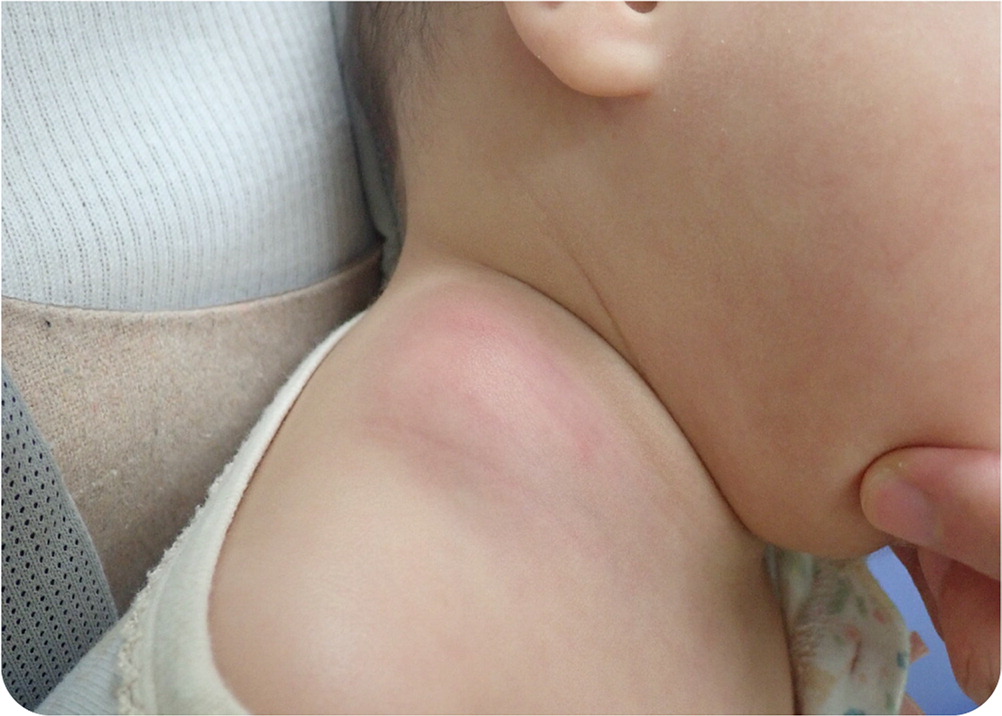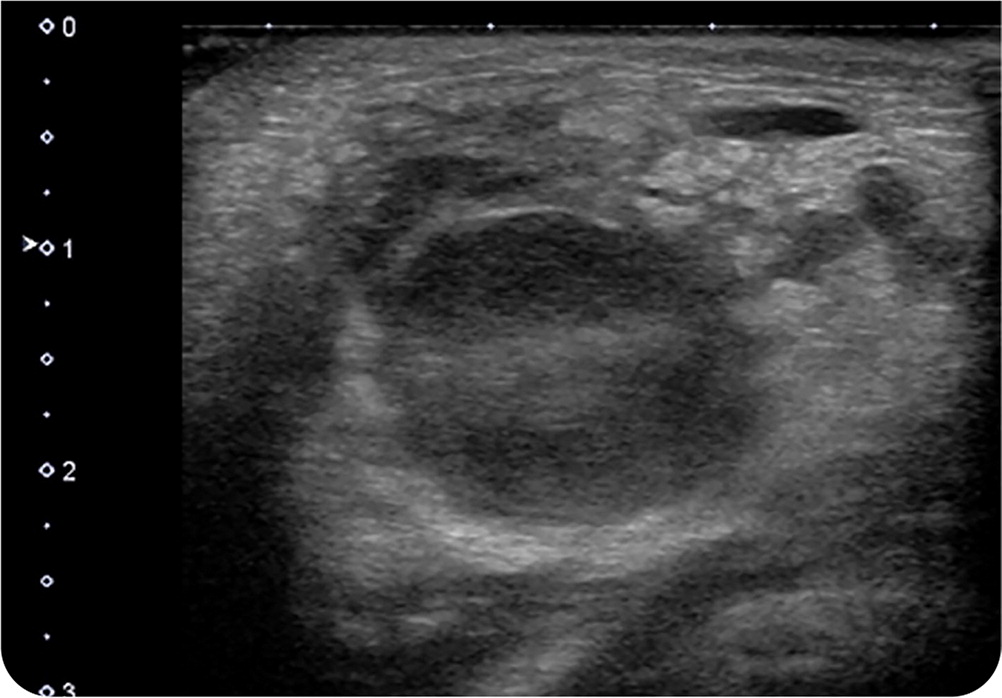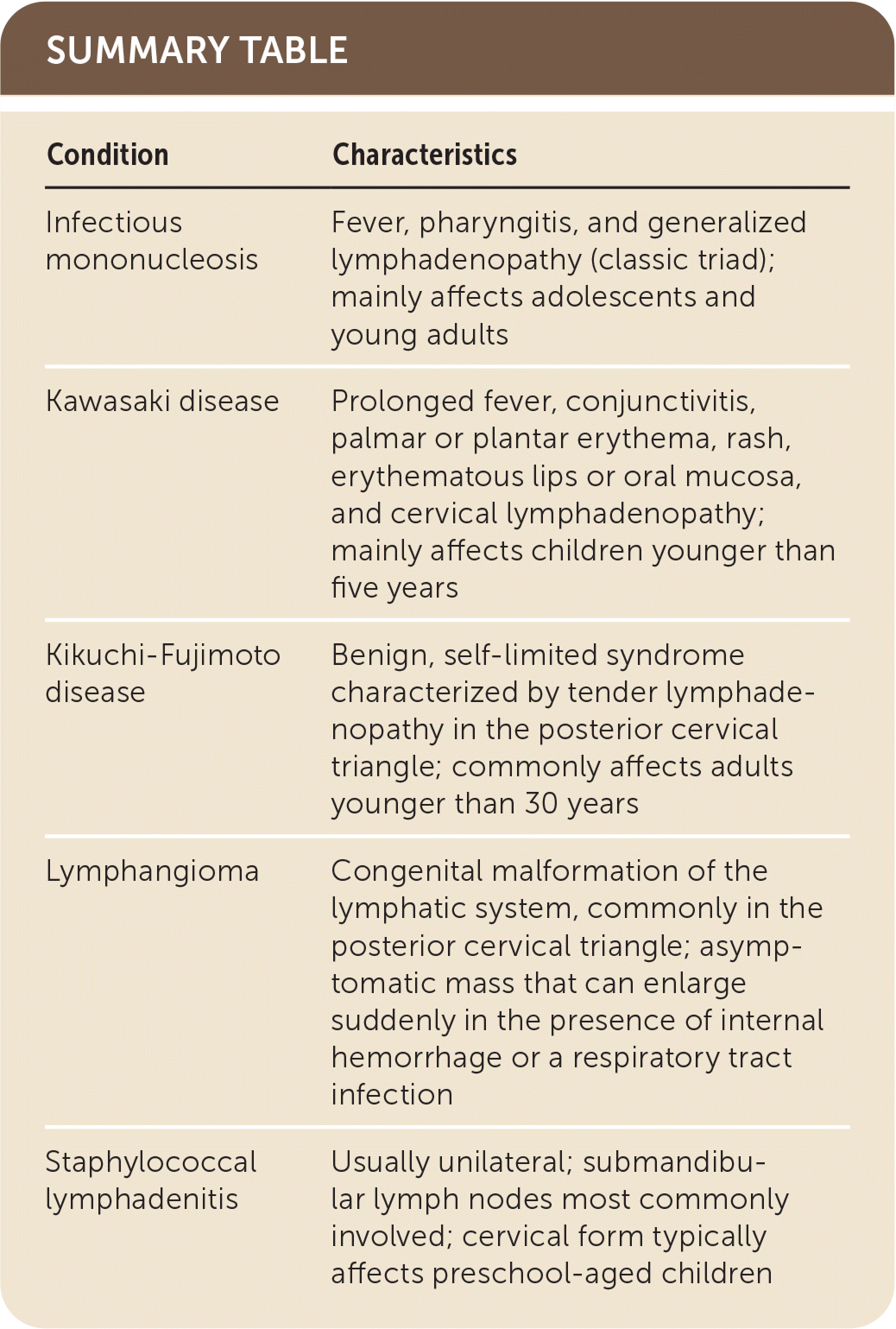
Am Fam Physician. 2022;105(4):423-424
Author disclosure: No relevant financial relationships.
An 11-month-old girl presented with a four-day history of fever and a mass on her neck. She had been diagnosed with hand-foot-and-mouth disease one week earlier. The patient had no recent animal exposure or travel. She had never experienced a similar episode and had no recent weight loss.
Physical examination revealed a mildly fluctuant mass in the lower end of the right posterior cervical triangle (Figure 1). The mass was warm to the touch and erythematous. The patient showed signs of irritation when the mass was palpated. She had no associated pharyngitis, hepatosplenomegaly, or other discernable masses. Ultrasonography was performed (Figure 2).


Question
Based on the patient’s history and physical examination findings, which one of the following is the most likely diagnosis?
A. Infectious mononucleosis.
B. Kawasaki disease.
C. Kikuchi-Fujimoto disease.
D. Lymphangioma.
E. Staphylococcal lymphadenitis.
Discussion
The correct answer is E: staphylococcal lymphadenitis. Ultrasonography of the neck lesion demonstrated a hypoechoic mass with thickening of the surrounding soft tissue. A fine needle aspiration of the mass confirmed Staphylococcus aureus infection, the most common cause of bacterial lymphadenitis. Staphylococcal cervical lymphadenitis typically affects preschool-aged children.1 A unilateral lesion occurs in 90% of children with the condition.2
The submandibular lymph nodes are affected in more than one-half of staphylococcal cervical lymphadenitis cases. Only 2% to 5% of cases develop in the lower cervical lymph nodes, as in this patient.1 Demonstration of a hypoechoic mass with peripheral vascularity is useful in differentiating suppurative staphylococcal lymphadenitis in atypical locations from other conditions.3
Infectious mononucleosis is caused by Epstein-Barr virus infection. It mainly affects adolescents and young adults and presents with the classic triad of fever, pharyngitis, and generalized lymphadenopathy. Almost all patients with the disease have some degree of splenomegaly on ultrasonography.4 Kawasaki disease is a medium vessel vasculitis that mainly affects children younger than five years. It is diagnosed by the presence of typical clinical findings, including a prolonged fever, conjunctivitis, palmar or plantar erythema, rash, erythematous lips or oral mucosa, and cervical lymphadenopathy. Delay in treatment may cause coronary artery aneurysms in approximately 20% of patients.5
Kikuchi-Fujimoto disease is a benign, self-limited syndrome characterized by tender lymphadenopathy localized to the posterior cervical triangle. It most commonly affects adults younger than 30 years and is diagnosed with a biopsy of the enlarged lymph nodes demonstrating necrosis with karyorrhexis and histiocytic infiltrate.6
Lymphangioma is a congenital malformation of the lymphatic system, commonly in the posterior cervical triangle. Most cases appear by two years of age, and around one-half are present at birth. Although lymphangioma is typically asymptomatic, it may suddenly enlarge in the presence of internal hemorrhage or a respiratory tract infection.7

| Condition | Characteristics |
|---|---|
| Infectious mononucleosis | Fever, pharyngitis, and generalized lymphadenopathy (classic triad); mainly affects adolescents and young adults |
| Kawasaki disease | Prolonged fever, conjunctivitis, palmar or plantar erythema, rash, erythematous lips or oral mucosa, and cervical lymphadenopathy; mainly affects children younger than five years |
| Kikuchi-Fujimoto disease | Benign, self-limited syndrome characterized by tender lymphadenopathy in the posterior cervical triangle; commonly affects adults younger than 30 years |
| Lymphangioma | Congenital malformation of the lymphatic system, commonly in the posterior cervical triangle; asymptomatic mass that can enlarge suddenly in the presence of internal hemorrhage or a respiratory tract infection |
| Staphylococcal lymphadenitis | Usually unilateral; submandibular lymph nodes most commonly involved; cervical form typically affects preschool-aged children |
